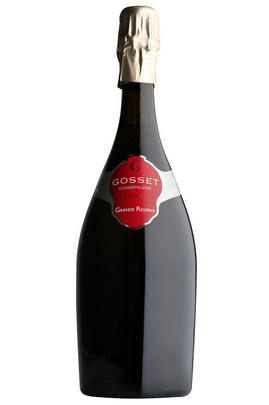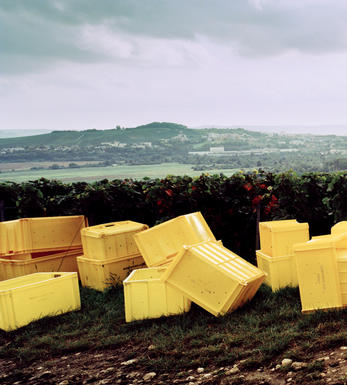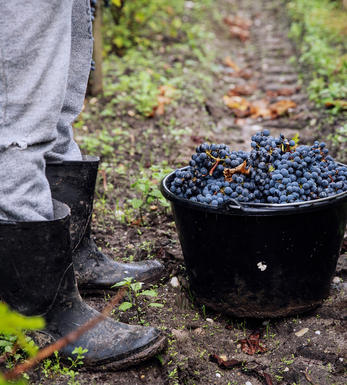
Champagne Gosset, Grande Réserve, Brut

Critics reviews
The price of the 75cl bottle, reduced from £49.75 previously, includes a 20% discount. This offer does not apply to BBX listings.
40% Chardonnay, 40% Pinot Noir and 20% Pinot Meunier. Champagne Gosset work with around 200 growers who, between them, have approximately 120 hectares, mainly around the premier and grand cru vineyards surrounding Épernay.
Each cru vinified separately, with no filtration and aged on fine lees. Malo is avoided and dosage is kept low as is the style of the house. Winemaker Odilon de Varine. TA 7.8 g/l, pH 3, RS 9 g/l. Vegan. Natural cork. Bottle weight 1,045 g.
Lots of age on the nose and depth on the palate. Still quite youthful!
Drink 2023 - 2027
Jancis Robinson MW, JancisRobinson.com (June 2023)
Aromas of crisp orchard fruit, pear and apricot, mingled with hints of fresh bread and pastry, introduce the latest release of Gosset's NV Brut Grande Réserve, a medium to full-bodied, fleshy but incisive wine that's deceptively generous but also structured to reward some bottle age.
Drink 2021 - 2031
William Kelley, Wine Advocate (September 2021)
This has attractive aromas of apricots, pie crust, raspberries, fresh walnuts and pears, with a hint of white pepper and ginger. Elegant, fine and supple mousse with a medium body and creamy layers of fresh fruit and pastries. It's so dry and clean.
45% Chardonnay, 45% Pinot Noir and 10% Meunier, based on 2017 vintage with 8% reserve wines. 7g/L dosage.
Drink now
James Suckling, JamesSuckling.com (July 2023)
The nose opens with the fresh ripeness of yellow apple and highlights of Granny Smith. It has beautifully subtle autolysis on the palate, deepening into notes of creamy apple crumble, Golden Delicious and Mirabelle plum, while remaining utterly strait-laced. Elegance, length and absolute freshness are inherent and quietly convincing.
Drink 2019 - 2028
Anne Krebiehl MW, Decanter.com
The NV Grande Reserve Brut, which is 45% Chardonnay, 45% Pinot Noir, and the rest Pinot Meunier and 8 g/l dosage, is lifted with tropical and citrus fruit, including lychee, orange blossom, and lime. Juicy and medium-bodied, with tangerine and mango, it is a solid entry to the range.
The oldest wine house in Champagne, established by Pierre Gosset in 1584 in Ay, Gosset, was purchased by Reynaud-Cointreau in 1993. Today, the chef de cave is Odilon de Varine, formerly of Deutz and Henriot, and the philosophy is to adapt to each year and avoid getting stuck in the past.
Each of the growers’ plots is fermented separately, and malolactic fermentation is entirely blocked, working with the lees to create roundness in the wines instead. The house has gradually shifted from being predominantly a Pinot Noir house to that of Chardonnay.
Total annual production is approximately 1 million bottles, though they can produce 1.5 million. They hold a considerable stock of reserve wine for 60 years, alleviating the pressures to put out more quantity. The 2008 bottlings of Celebris tasted here represent only the eighth release of that cuvée.
Drink 2022 - 2028
Jeb Dunnuck, JebDunnuck.com (November 2022)
The NV Grande Réserve is a gorgeous entry-level wine from Gosset. Crisp, dry and resonant, the Grande Réserve offers lovely textural depth to play off the more mineral-driven notes that are so typical of the Gosset house style.
All the elements come together nicely in this effortless, gracious mid-weight Champagne. This is very nicely done. Disgorged on April 26, 2017. Dosage is 8 grams per liter.
Drink 2017 - 2024
Antonio Galloni, Vinous.com (December 2017)
About this WINE

Gosset
Gosset is the oldest wine-producer in Champagne, with a history stretching back to 1584 – when red, rather than sparkling wines were the region’s calling card.
Situated in the tiny Grand Cru village of Aÿ, five kilometres from Epernay, quality-focused Gosset has some rather famous neighbours, including Bollinger; its production, however, is much below that of the larger Houses, at around 1.3 million bottles (Moët & Chandon, for comparison, makes close to 30 million).
Gosset crafts truly artisan and gastronomic Champagnes, wines which are often seen in Michelin-star restaurants across the world. Newly appointed Chef de Caves Odilon de Varine (who took over in 2016) carries on the hallmark style of the House: extended aging “sur lees” in the cellars gives the wines extra richness and complexity in the finished glass, while the wines often don’tt undergo malolactic fermentation, to preserve the wines’ acidity and freshness. The results tend to be very creamy, dry and full, with rich, biscuit notes, framed by a trademark mineral freshness.
The House produces a range of different wines, including a range of non-vintage bottlings: the House’s flagship multi-vintage blend Grande Réserve, its Blanc de Blancs and Rosé. As for vintage wines, its Grand Millésime is joined by the “prestige” Celebris cuvées, which are only produced in the very best years.
Today the House is owned by the Renaud-Cointreau group, a family firm that also owns Cognac Frapin.

Brut Champagne
Brut denotes a dry style of Champagne (less than 15 grams per litre). Most Champagne is non-vintage, produced from a blend from different years. The non-vintage blend is always based predominately on wines made from the current harvest, enriched with aged wines (their proportion and age varies by brand) from earlier harvests, which impart an additional level of complexity to the end wine. Champagnes from a single vintage are labelled with the year reference and with the description Millésimé.
Non-vintage Champagnes can improve with short-term ageing (typically two to three years), while vintages can develop over much longer periods (five to 30 years). The most exquisite and often top-priced expression of a house’s style is referred to as Prestige Cuvée. Famous examples include Louis Roederer's Cristal, Moët & Chandon's Dom Pérignon, and Pol Roger's Cuvée Sir Winston Churchill.
Recommended Producers : Krug, Billecart Salmon, Pol Roger, Bollinger, Salon, Gosset, Pierre Péters, Ruinart

Champagne blend
Which grapes are included in the blend, and their proportion, is one of the key factors determining the style of most Champagnes. Three grapes are used - Pinot Noir, Chardonnay and Pinot Meunier.
26% of vineyards in Champagne are planted with Chardonnay and it performs best on the Côtes des Blancs and on the chalk slopes south of Epernay. It is relatively simple to grow, although it buds early and thus is susceptible to spring frosts. It produces lighter, fresher wines than those from Burgundy and gives finesse, fruit and elegance to the final blend. It is the sole grape in Blancs de Blancs, which are some of the richest long-lived Champagnes produced.
Pinot Noir accounts for nearly 40% of the plantings in Champagne and lies at the heart of most blends - it gives Champagne its body, structure, strength and grip. It is planted across Champagne and particularly so in the southern Aube district.
The final component is Pinot Meunier and this constitutes nearly 35% of the plantings. Its durability and resistance to spring frosts make the Marne Valley, a notorious frost pocket, its natural home. It ripens well in poor years and produces a soft, fruity style of wine that is ideal for blending with the more assertive flavours of Pinot Noir. Producers allege that Pinot Meunier lacks ageing potential, but this does not deter Krug from including around 15% of it in their final blends.


Buying options
Add to wishlist
Description
40% Chardonnay, 40% Pinot Noir and 20% Pinot Meunier. Champagne Gosset work with around 200 growers who, between them, have approximately 120 hectares, mainly around the premier and grand cru vineyards surrounding Épernay.
Each cru vinified separately, with no filtration and aged on fine lees. Malo is avoided and dosage is kept low as is the style of the house. Winemaker Odilon de Varine. TA 7.8 g/l, pH 3, RS 9 g/l. Vegan. Natural cork. Bottle weight 1,045 g.
Lots of age on the nose and depth on the palate. Still quite youthful!
Drink 2023 - 2027
Jancis Robinson MW, JancisRobinson.com (June 2023)
wine at a glance
Delivery and quality guarantee